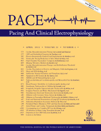Adenosine-Dependent Concealed Accessory Pathway
Abstract
Adenosine is routinely used during ventricular pacing to exclude the persistence of retrograde accessory pathways conduction after radiofrequency (RF) ablation procedures by blocking conduction over the atrioventricular node. This is the first report of an adenosine-dependent concealed accessory pathway demonstrating transient conduction only after adenosine administration. Our findings may have potential clinical implications in reducing recurrence after accessory pathway ablation. Furthermore, it may add relevant information regarding the ability of adenosine to elicit dormant conduction after RF ablation, a phenomenon that has acquired considerable interest in the era of pulmonary vein isolation. PACE 2012; 35:e91–e93)




